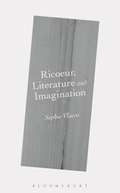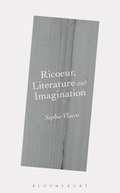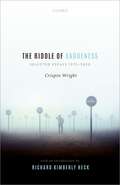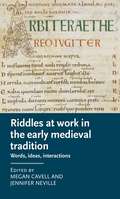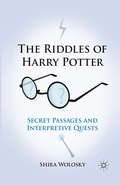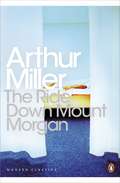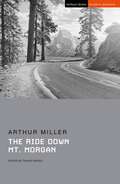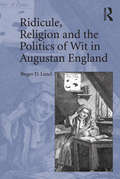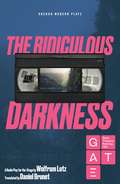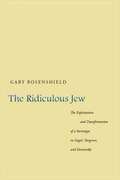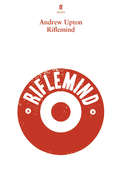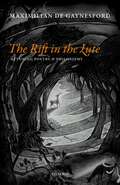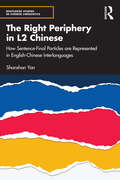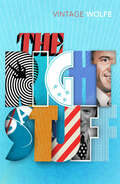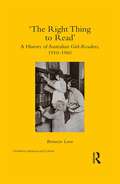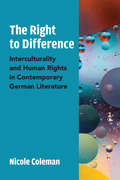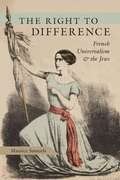- Table View
- List View
Ricoeur, Literature and Imagination
by Sophie Vlacos"To explain more is to understand better". This is the mantra by which French philosopher Paul Ricoeur lived and worked, establishing himself as one of the twentieth century's most lucid and broad-ranging critical thinkers. A prisoner of war at 27, Ricoeur was also Dean of Paris X Nanterre during the student disturbances of 1968. In later years he became an outspoken champion of social justice. In work as in life, Ricoeur was committed to the challenges of conflict and the prospect of authentic resolution. Deeply indebted to phenomenology and the hermeneutical tradition of Heidegger and Gadamer, Ricoeur was also an advocate of structural linguistics, of psychoanalysis, and a rare conversant with the Anglo-American analytic tradition. This volume explores how literature and the conflicts of literary-theoretical debate inform Ricoeur's theory of imagination and understanding, and how Ricoeur's unique mode of literary reflection resolves the conflicts of literature's theoretical heyday, presaging a new direction for literary studies.
Ricoeur, Literature and Imagination
by Sophie Vlacos"To explain more is to understand better". This is the mantra by which French philosopher Paul Ricoeur lived and worked, establishing himself as one of the twentieth century's most lucid and broad-ranging critical thinkers. A prisoner of war at 27, Ricoeur was also Dean of Paris X Nanterre during the student disturbances of 1968. In later years he became an outspoken champion of social justice. In work as in life, Ricoeur was committed to the challenges of conflict and the prospect of authentic resolution. Deeply indebted to phenomenology and the hermeneutical tradition of Heidegger and Gadamer, Ricoeur was also an advocate of structural linguistics, of psychoanalysis, and a rare conversant with the Anglo-American analytic tradition. This volume explores how literature and the conflicts of literary-theoretical debate inform Ricoeur's theory of imagination and understanding, and how Ricoeur's unique mode of literary reflection resolves the conflicts of literature's theoretical heyday, presaging a new direction for literary studies.
The Riddle of Vagueness: Selected Essays 1975-2020
by Crispin WrightIt was well known to the Greeks that the phenomenon of vagueness in natural language gives rise to hard problems and paradoxes, yet more than two millennia passed before Philosophy began to pay any degree of concerted attention to the challenges of vagueness to match the effort expended, for example, on the Liar paradox and its kin. This situation changed dramatically in the last quarter of the twentieth century, when the Sorites paradox in particular began to provoke a dramatic intensification of research and publication. Crispin Wright has been in the international vanguard of the resulting modern debates that have attracted some of the most distinguished contemporary philosophers of logic and language. The Riddle of Vagueness collects together fourteen of Wright's highly influential publications in this field. The chapters together encompass almost half a century of evolving thought on the central problems and challenges which vagueness poses: what exactly is vagueness, what does its pervasiveness in natural language show about the nature of language mastery, is it desirable to modify classical logic and semantics in the face of the Sorites and, if so, what form should the modifications take? Richard Kimberly Heck contributes a substantial introduction to the volume, providing an invaluable summary of these fundamental issues, and an overview and evaluation in depth of the evolving course of Wright's ideas about them.
The Riddle of Vagueness: Selected Essays 1975-2020
by Crispin WrightIt was well known to the Greeks that the phenomenon of vagueness in natural language gives rise to hard problems and paradoxes, yet more than two millennia passed before Philosophy began to pay any degree of concerted attention to the challenges of vagueness to match the effort expended, for example, on the Liar paradox and its kin. This situation changed dramatically in the last quarter of the twentieth century, when the Sorites paradox in particular began to provoke a dramatic intensification of research and publication. Crispin Wright has been in the international vanguard of the resulting modern debates that have attracted some of the most distinguished contemporary philosophers of logic and language. The Riddle of Vagueness collects together fourteen of Wright's highly influential publications in this field. The chapters together encompass almost half a century of evolving thought on the central problems and challenges which vagueness poses: what exactly is vagueness, what does its pervasiveness in natural language show about the nature of language mastery, is it desirable to modify classical logic and semantics in the face of the Sorites and, if so, what form should the modifications take? Richard Kimberly Heck contributes a substantial introduction to the volume, providing an invaluable summary of these fundamental issues, and an overview and evaluation in depth of the evolving course of Wright's ideas about them.
Riddles at work in the early medieval tradition: Words, ideas, interactions (Manchester Medieval Literature and Culture)
by Megan Cavell Jennifer NevilleCapitalising on developments in the field over the past decade, Riddles at work provides an up-to-date microcosm of research on the early medieval riddle tradition. The book presents a wide range of traditional and experimental methodologies. The contributors treat the riddles both as individual poems and as parts of a tradition, but, most importantly, they address Latin and Old English riddles side-by-side, bringing together texts that originally developed in conversation with each other but have often been separated by scholarship. Together, the chapters reveal that there is no single, right way to read these texts but rather a multitude of productive paths. This book will appeal to students and scholars of early medieval studies. It contains new as well as established voices, including Jonathan Wilcox, Mercedes Salvador-Bello and Jennifer Neville.
Riddles at work in the early medieval tradition: Words, ideas, interactions (Manchester Medieval Literature and Culture)
by David MatthewsCapitalising on developments in the field over the past decade, Riddles at work provides an up-to-date microcosm of research on the early medieval riddle tradition. The book presents a wide range of traditional and experimental methodologies. The contributors treat the riddles both as individual poems and as parts of a tradition, but, most importantly, they address Latin and Old English riddles side-by-side, bringing together texts that originally developed in conversation with each other but have often been separated by scholarship. Together, the chapters reveal that there is no single, right way to read these texts but rather a multitude of productive paths. This book will appeal to students and scholars of early medieval studies. It contains new as well as established voices, including Jonathan Wilcox, Mercedes Salvador-Bello and Jennifer Neville.
The Riddles of Harry Potter: Secret Passages and Interpretive Quests
by Shira WoloskyThe Riddles of Harry Potter draws readers into the deeper meanings of these phenomenally successful books, arguing that they launch and pursue interpretive quests in an ongoing effort to understand patterns and their attendant meanings, implications, and consequences.
The Ride Down Mt. Morgan (Penguin Modern Classics)
by Arthur MillerA car wreck on the slopes of Mount Morgan puts insurance tycoon Lyman Felt in the hospital. While Lyman recovers, two women meet in the hospital waiting room only to discover that they are both married to him. With his secrets exposed, Lyman tries to justify himself to the two women - the prim, cultured Theo and the restless, ambitious Leah - at the same time hoping to convince himself that he is blameless. Moving between broad farce and delicate tragedy, The Ride Down Mt. Morgan explores the struggle between honesty with others and honesty with oneself.
The Ride Down Mt. Morgan (Student Editions)
by Arthur Miller'Mr. Miller knows his audience… he is letting us know, the devil will have his due.' NEW YORK TIMESWhen insurance agent Lyman Felt is hospitalised following a near-fatal car crash, both of his wives show up at his bedside and his duplicitous bigamy is revealed. As his shocked spouses – the prim Theo and the assertive Leah – reel from this revelation and their husband's hypocrisy, an outrageous question is presented: is marriage actually easier this way?Touching on themes of betrayal, crisis and reconciliation, The Ride Down Mt. Morgan is one of Miller's more controversial works, and was nominated for the Tony Award for Best Play in 1991. This Methuen Drama Student Edition is edited by Thiago Russo, with commentary and notes that explore the play's production history (including excerpts from an interview with director David Esbjornson) as well as the dramatic, thematic and academic debates that surround it.
The Ride Down Mt. Morgan (Student Editions)
by Arthur Miller'Mr. Miller knows his audience… he is letting us know, the devil will have his due.' NEW YORK TIMESWhen insurance agent Lyman Felt is hospitalised following a near-fatal car crash, both of his wives show up at his bedside and his duplicitous bigamy is revealed. As his shocked spouses – the prim Theo and the assertive Leah – reel from this revelation and their husband's hypocrisy, an outrageous question is presented: is marriage actually easier this way?Touching on themes of betrayal, crisis and reconciliation, The Ride Down Mt. Morgan is one of Miller's more controversial works, and was nominated for the Tony Award for Best Play in 1991. This Methuen Drama Student Edition is edited by Thiago Russo, with commentary and notes that explore the play's production history (including excerpts from an interview with director David Esbjornson) as well as the dramatic, thematic and academic debates that surround it.
Ridicule, Religion and the Politics of Wit in Augustan England
by Roger D. LundArguing for the importance of wit beyond its use as a literary device, Roger D. Lund outlines the process by which writers in Restoration and eighteenth-century England struggled to define an appropriate role for wit in the public sphere. He traces its unpredictable effects in works of philosophy, religious pamphlets, and legal writing and examines what happens when literary wit is deliberately used to undermine the judgment of individuals and to destabilize established institutions of church and state. Beginning with a discussion of wit's association with deception, Lund suggests that suspicion of wit and the imagination emerges in attacks on the Restoration stage, in the persecution of The Craftsman, and in criticism directed at Thomas Hobbes's Leviathan and works by writers like the Earl of Shaftesbury, Thomas Woolston, and Thomas Paine. Anxieties about wit, Lund shows, were in part responsible for attempts to suppress new communal venues such as coffee houses and clubs and for the Church's condemnation of the seditious pamphlets made possible by the lapse of the Licensing Act in 1695. Finally, the establishment's conviction that wit, ridicule, satire, and innuendo are subversive rhetorical forms is glaringly at play in attempts to use libel trials to translate the fear of wit as a metaphorical transgression of public decorum into an actual violation of the civil code.
Ridicule, Religion and the Politics of Wit in Augustan England
by Roger D. LundArguing for the importance of wit beyond its use as a literary device, Roger D. Lund outlines the process by which writers in Restoration and eighteenth-century England struggled to define an appropriate role for wit in the public sphere. He traces its unpredictable effects in works of philosophy, religious pamphlets, and legal writing and examines what happens when literary wit is deliberately used to undermine the judgment of individuals and to destabilize established institutions of church and state. Beginning with a discussion of wit's association with deception, Lund suggests that suspicion of wit and the imagination emerges in attacks on the Restoration stage, in the persecution of The Craftsman, and in criticism directed at Thomas Hobbes's Leviathan and works by writers like the Earl of Shaftesbury, Thomas Woolston, and Thomas Paine. Anxieties about wit, Lund shows, were in part responsible for attempts to suppress new communal venues such as coffee houses and clubs and for the Church's condemnation of the seditious pamphlets made possible by the lapse of the Licensing Act in 1695. Finally, the establishment's conviction that wit, ridicule, satire, and innuendo are subversive rhetorical forms is glaringly at play in attempts to use libel trials to translate the fear of wit as a metaphorical transgression of public decorum into an actual violation of the civil code.
The Ridiculous Darkness (Oberon Modern Plays)
by Wolfram Lotz“I have a right to appear here. Otherwise, who will listen to me? Where should I talk about myself, if not here?” Ultimo has a degree in piracy from Mogadishu University of Applied Sciences. Tofdau won’t rest until his story’s told. Sergeant Pellner and Officer Dorsch are sailing up the Hindu Kush in search of Lieutenant Colonel Deutinger in the rainforest of Afghanistan. And at his parents’ home in Bad Rippoldsau, Wolfram Lotz is experiencing writer’s block. Critically acclaimed dark comedy The Ridiculous Darkness, by award-winning German playwright Wolfram Lotz, is a surreal, hilarious and powerful response to Heart of Darkness and Apocalypse Now that invites us to rethink colonial narratives, confront our ideas of each other and question what we imagine is in the darkness. Four black femmes. Three revered White Male Writers. Two classic works. A radical deconstruction.
The Ridiculous Jew: The Exploitation and Transformation of a Stereotype in Gogol, Turgenev, and Dostoevsky
by Gary RosenshieldThis book is a study devoted to exploring the use of a Russian version of the Jewish stereotype (the ridiculous Jew) in the works of three of the greatest writers of the nineteenth century. Rosenshield does not attempt to expose the stereotype—which was self-consciously and unashamedly employed. Rather, he examines how stereotypes are used to further the very different artistic, cultural, and ideological agendas of each writer. What distinguishes this book from others is that it explores the problems that arise when an ethnic stereotype is so fully incorporated into a work of art that it takes on a life of its own, often undermining the intentions of its author as well as many of the defining elements of the stereotype itself. With each these writers, the Jewish stereotype precipitates a literary transformation, taking their work into an uncomfortable space for the author and a challenging one for readers.
Riflemind
by Andrew UptonTwenty years after their frontman, John, walked off stage for good, the ironic rock band Riflemind are set to get together again. For John, a reunion might be his second chance; for his wife, Lyn, it could be the end of the world as she knows it . . . As the band descend upon John's country manor, this weekend fast becomes the ultimate test of talent, friendship and loyalty.Originally produced by Sydney Theatre Company, Riflemind received its UK premiere at the Trafalgar Studio, London, in September 2008.
The Rift in The Lute: Attuning Poetry and Philosophy
by Maximilian de GaynesfordWhat is it for poetry to be serious and to be taken seriously? What is it to be open to poetry, exposed to its force, attuned to what it says and alive to what it does? These are important questions that call equally on poetry and philosophy. But poetry and philosophy, notoriously, have an ancient quarrel. Maximilian de Gaynesford sets out to understand and convert their mutual antipathy into something mutually enhancing, so that we can begin to answer these and other questions. The key to attuning poetry and philosophy lies in the fact that poetic utterances are best appreciated as doing things. For it is as doing things that the speech act approach in analytic philosophy of language tries to understand all utterances. Taking such an approach, this book offers ways to enhance our appreciation of poetry and to develop our understanding of philosophy. It explores work by a range of poets from Chaucer to Geoffrey Hill and J. H. Prynne, and culminates in an extended study of Shakespeare's Sonnets. What work does poetry set itself, and how does this determine the way it is to be judged? What do poets commit themselves to, and what they may be held responsible for? What role does a poet have, or their audience, or their context, in determining the meaning of a poem, what work it is able to achieve? These are the questions that an attuned approach is able to ask and answer.
The Rift in The Lute: Attuning Poetry and Philosophy
by Maximilian de GaynesfordWhat is it for poetry to be serious and to be taken seriously? What is it to be open to poetry, exposed to its force, attuned to what it says and alive to what it does? These are important questions that call equally on poetry and philosophy. But poetry and philosophy, notoriously, have an ancient quarrel. Maximilian de Gaynesford sets out to understand and convert their mutual antipathy into something mutually enhancing, so that we can begin to answer these and other questions. The key to attuning poetry and philosophy lies in the fact that poetic utterances are best appreciated as doing things. For it is as doing things that the speech act approach in analytic philosophy of language tries to understand all utterances. Taking such an approach, this book offers ways to enhance our appreciation of poetry and to develop our understanding of philosophy. It explores work by a range of poets from Chaucer to Geoffrey Hill and J. H. Prynne, and culminates in an extended study of Shakespeare's Sonnets. What work does poetry set itself, and how does this determine the way it is to be judged? What do poets commit themselves to, and what they may be held responsible for? What role does a poet have, or their audience, or their context, in determining the meaning of a poem, what work it is able to achieve? These are the questions that an attuned approach is able to ask and answer.
The Right Periphery in L2 Chinese: How Sentence-Final Particles are Represented in English-Chinese Interlanguages (Routledge Studies in Chinese Linguistics)
by Shanshan YanThe Right Periphery in L2 Chinese is among the first books to try to incorporate both advanced linguistic and acquisition perspectives to show how eight sentence-final particles are represented in English-speaking learners’ L2 Chinese. This book will inform researchers of the general construction of the right periphery in L2 grammars. Drawing on up-to-date theoretical frameworks and findings from advanced empirical studies, it sketches the general picture of the periphery that these particles occupy in English-Chinese interlanguages. Readers will grasp the problems and difficulties, and particularly the ambiguities, which learners of Chinese must grapple with in the process of acquiring sentence-final particles. Possible influential factors underlying the acquisition process are explicitly discussed as well. Researchers will also find insights in the advanced methodologies and statistics that are used to study Chinese. The book will be illuminating for researchers interested in SLA, linguists of generative theories, and educators teaching Chinese as a second/foreign language.
The Right Periphery in L2 Chinese: How Sentence-Final Particles are Represented in English-Chinese Interlanguages (Routledge Studies in Chinese Linguistics)
by Shanshan YanThe Right Periphery in L2 Chinese is among the first books to try to incorporate both advanced linguistic and acquisition perspectives to show how eight sentence-final particles are represented in English-speaking learners’ L2 Chinese. This book will inform researchers of the general construction of the right periphery in L2 grammars. Drawing on up-to-date theoretical frameworks and findings from advanced empirical studies, it sketches the general picture of the periphery that these particles occupy in English-Chinese interlanguages. Readers will grasp the problems and difficulties, and particularly the ambiguities, which learners of Chinese must grapple with in the process of acquiring sentence-final particles. Possible influential factors underlying the acquisition process are explicitly discussed as well. Researchers will also find insights in the advanced methodologies and statistics that are used to study Chinese. The book will be illuminating for researchers interested in SLA, linguists of generative theories, and educators teaching Chinese as a second/foreign language.
The Right Stuff (Great Books Ser.)
by Tom WolfeA wildly vivid and entertaining chronicle of America's manned space program, from the author of The Electric Kool-Aid Acid TestWITH AN INTRODUCTION BY US ASTRONAUT SCOTT KELLY‘What is it’ asks Tom Wolfe, ‘that makes a man willing to sit on top of an enormous Roman Candle…and wait for someone to light the fuse?’ Arrogance? Stupidity? Bravery? Courage? Or, simply, that quality we call 'the right stuff'?A monument to the men who battled to beat the Russians into space, The Right Stuff is a voyage into the mythology of the American space program, and a dizzying dive into the sweat, fear, beauty and danger of being on the white-hot edge of history in the making.‘Tom Wolfe at his very best… Learned, cheeky, risky, touching, tough, compassionate, nostalgic, worshipful, jingoistic...The Right Stuff is superb’ - New York Times Book Review
‘The Right Thing to Read’: A History of Australian Girl-Readers, 1910-1960
by Bronwyn Lowe‘The Right Thing to Read’: A History of Australian Girl-Readers, 1910-1960 explores the reading habits, identity, and construction of femininity of Australian girls aged between ten and fourteen from 1910 to 1960. It investigates changing notions of Australian girlhood across the period, and explores the ways that parents, teachers, educators, journalists and politicians attempted to mitigate concerns about girls’ development through the promotion of ‘healthy’ literature. The book also addresses the influence of British publishers to Australian girl-readers and the growing importance of Australian publishers throughout the period. It considers the rise of Australian literary nationalism in the global context, and the increasing prominence of Australian literature in the period after the Second World War. It also shows how access to reading material improved for girls over the first half of the last century.
‘The Right Thing to Read’: A History of Australian Girl-Readers, 1910-1960
by Bronwyn Lowe‘The Right Thing to Read’: A History of Australian Girl-Readers, 1910-1960 explores the reading habits, identity, and construction of femininity of Australian girls aged between ten and fourteen from 1910 to 1960. It investigates changing notions of Australian girlhood across the period, and explores the ways that parents, teachers, educators, journalists and politicians attempted to mitigate concerns about girls’ development through the promotion of ‘healthy’ literature. The book also addresses the influence of British publishers to Australian girl-readers and the growing importance of Australian publishers throughout the period. It considers the rise of Australian literary nationalism in the global context, and the increasing prominence of Australian literature in the period after the Second World War. It also shows how access to reading material improved for girls over the first half of the last century.
The Right to Difference: Interculturality and Human Rights in Contemporary German Literature
by Nicole ColemanThe Right to Difference examines novels that depict human rights violations in order to explore causes of intergroup violence within diverse societies, using Germany as a test case. In these texts, the book shows that an exaggeration of difference between minority and majority groups leads to violence. Germany has become increasingly diverse over the past decades due to skilled labor migration and refugee movements. In light of this diversity, this book’s approach transcends a divide between migrant and post-migrant German literature on the one hand and a national literature on the other hand. Addressing competing definitions of national identity as well as the contest between cultural homogeneity and diversity, the author redefines the term “intercultural literature.” It becomes not a synonym for authors who do not belong to a national literature, such as migrant writers, but a way of reading literature with an intercultural lens. This book builds a theory of intercultural literature that focuses on the multifaceted nature of identity, in which ethnicity represents only one of many characteristics defining individuals. To develop intercultural competence, one needs to adopt a complex image of individuals that allows for commonalities and differences by complicating the notion of sharp contrasts between groups. Revealing the affective allegiances formed around other characteristics (gender, profession, personal motivations, relationships, and more) allows for similarities that grouping into large, homogeneous, and seemingly exclusive entities conceals. Eight novels analyzed in this book remember and reveal human rights violations, such as genocide, internment and torture, violent expulsion, the reasons for fleeing a country, dangerous flight routes and the difficulty of settling in a new country. Some of these novels allow for affective identification with diverse characters and cast the protagonists as individuals with plural perspectives and identities rather than monolithic members of one large national or ethnic group, whereas others emphasize the commonalities of all people. Ultimately, the author makes the case for German Studies to contribute to an antiracist approach to diversity by redefining what it means to be German and establishing difference as a fundamental human right
The Right to Difference: French Universalism and the Jews
by Maurice SamuelsUniversal equality is a treasured political concept in France, but recent anxiety over the country’s Muslim minority has led to an emphasis on a new form of universalism, one promoting loyalty to the nation at the expense of all ethnic and religious affiliations. This timely book offers a fresh perspective on the debate by showing that French equality has not always demanded an erasure of differences. Through close and contextualized readings of the way that major novelists, philosophers, filmmakers, and political figures have struggled with the question of integrating Jews into French society, Maurice Samuels draws lessons about how the French have often understood the universal in relation to the particular. Samuels demonstrates that Jewish difference has always been essential to the elaboration of French universalism, whether as its foil or as proof of its reach. He traces the development of this discourse through key moments in French history, from debates over granting Jews civil rights during the Revolution, through the Dreyfus Affair and Vichy, and up to the rise of a “new antisemitism” in recent years. By recovering the forgotten history of a more open, pluralistic form of French universalism, Samuels points toward new ways of moving beyond current ethnic and religious dilemmas and argues for a more inclusive view of what constitutes political discourse in France.
The Right to Difference: French Universalism and the Jews
by Maurice SamuelsUniversal equality is a treasured political concept in France, but recent anxiety over the country’s Muslim minority has led to an emphasis on a new form of universalism, one promoting loyalty to the nation at the expense of all ethnic and religious affiliations. This timely book offers a fresh perspective on the debate by showing that French equality has not always demanded an erasure of differences. Through close and contextualized readings of the way that major novelists, philosophers, filmmakers, and political figures have struggled with the question of integrating Jews into French society, Maurice Samuels draws lessons about how the French have often understood the universal in relation to the particular. Samuels demonstrates that Jewish difference has always been essential to the elaboration of French universalism, whether as its foil or as proof of its reach. He traces the development of this discourse through key moments in French history, from debates over granting Jews civil rights during the Revolution, through the Dreyfus Affair and Vichy, and up to the rise of a “new antisemitism” in recent years. By recovering the forgotten history of a more open, pluralistic form of French universalism, Samuels points toward new ways of moving beyond current ethnic and religious dilemmas and argues for a more inclusive view of what constitutes political discourse in France.
